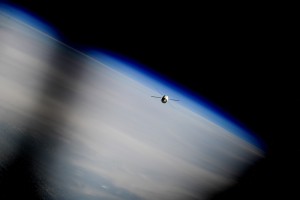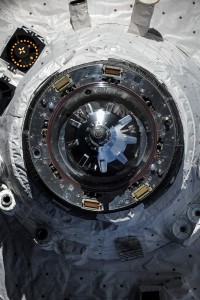ESA’s ATV-5 mission manager Massimo Cislaghi sent this mid-mission report on ATV Georges Lemaître:
About 3.5 months have passed since the launch of ATV Georges Lemaître on 29 July, and about 3.5 months are left before the end of its mission. We do not have a fixed date yet, but we are targeting the end of February 2015.
Therefore, as my more famous compatriot Dante Alighieri used to say “nel mezzo del cammin di nostra vita …” or “halfway through the journey of our life…” I take the liberty to provide you with a short summary of how the mission is going, even if this could be summarised with just one word: EXCELLENT.
Touching wood or any other material/object according to your culture, so far we have had only one Flight Segment anomaly that was related to the propulsion subsystem. It appeared immediately after separation from the launcher, was quickly understood and temporarily resolved well before the docking of 12 August. We definitively closed the anomaly a few days afterwards. Concerning operations, so far we have had only four Operations Problem Reports. By comparison, after 3.5 months of the ATV Albert Einstein mission we had accumulated seven Flight Segment anomalies and twelve Operations Problem Reports, and at the same stage of the ATV Edoardo Amaldi mission we were already at nine and nineteen respectively.
Any fears we had before rendezvous with the International Space Station that the Kurs equipment would not behave correctly disappeared when we switched it on at about 3.5 km from the Station. In fact we never had such good Kurs data during the previous four missions. Virtually no disturbances at all were experienced on the TDRSS system, which had given us some headaches for the last two ATVs. The docking accuracy was at least as good as for ATV-4with ATV’s probe perfectly centring the in the Space Station’s socket. After hatch opening the Space Station crew quickly confirmed that a hypothetical presence of particles in the pressurised module, was just that: a hypothetical problem.
One of the novelties of this ATV mission is the presence as passenger of LIRIS that is used to collect infrared and LIDAR images as a technological demonstrations. These images were recorded during a special Space Station flyunder manoeuvre performed on 8 August, as well as during the real Space Station rendezvous. The data was stored on board, and then physically downloaded with the Soyuz spacecraft that returned to Earth on 11 September. The initial exploitation of these data is indicating that also this unique part of ATV-5’s mission has been successful.
Concerning the basic reason of every ATV mission to support logistics, so far we have transferred to the Space Station all of the Russian fuel and of the oxygen delivered in orbit, about half of the dry cargo and 10% of water as well, while no air transfer has been performed so far. From the ATV propulsive standpoint, we have performed three Space Station reboosts, several Space Station attitude control manoeuvres, and on 27 October for the first time in ATV history we performed a Predetermined Debris Avoidance Manoeuvre, which is a new feature that allows mission control to reduce the warning required before space debris could hit the Station from about 24 to about 6 hours.
What comes next ? Completing the normal cargo unloading and loading with Space Station trash as well as performing several Space Station propulsive support operations will keep the ESA, CNES and IOT teams in Toulouse busy for the coming weeks, including during the Christmas and New Year period. We are now focusing our efforts towards the implementation of the second novelty of this mission, the so-called “shallow reentry”, aiming to collect experimental data to be used for validating analytical models that will be used for the future destructive reentry of the International Space Station. I will expand a bit more on this topic in one of my future messages.
To finish in style, the list of the Georges Lemaître’s records, some already achieved and some potential ones:
- ATV-5 is the heaviest vehicle ever lifted by an Ariane rocket (20,245 kg)
- ATV-5 has delivered the largest quantity of dry cargo to the International Space Station in a European spacecraft (2,680 kg)
- ATV-5 was loaded with the largest quantity of late cargo just three weeks before launch (1,234 kg)
- ATV-5 uploaded the largest quantity of potable water to the Space Station (843 kg)
- ATV-5 uploaded the largest quantity of gas to the Space Station (100 kg) – (equal to ATV-2, ATV-3 and ATV-4)
- ATV-5 uploaded and delivered the largest quantity of Russian fuel to the ISS (860 kg) – (equal to the previous ATVs)
- ATV-5 performed the first Space Station Predetermined Debris Avoidance Manoeuvre
- If ATV-5 undocks on 10 February 2015, it’s attached phase will have been 182 days, or just two days less than ATV-3, which undocked five days later than planned
- If ATV-5 reenters on 24 February 2015, it’s total in-orbit duration will have been of 210 days, or six days more than ATV-1






 Automated Transfer Vehicle page
Automated Transfer Vehicle page ATV blog archive
ATV blog archive
Discussion: one comment
Well done!
Already curious to find out why ATV-5 will burn-up during its re-entry?!?
Well then, watch my contribution to the “ATV education challenge”, in which I explain and demonstrate why ATV-5 will burn-up during its re-entry:
https://www.youtube.com/watch?v=jsbxCTVhjbk